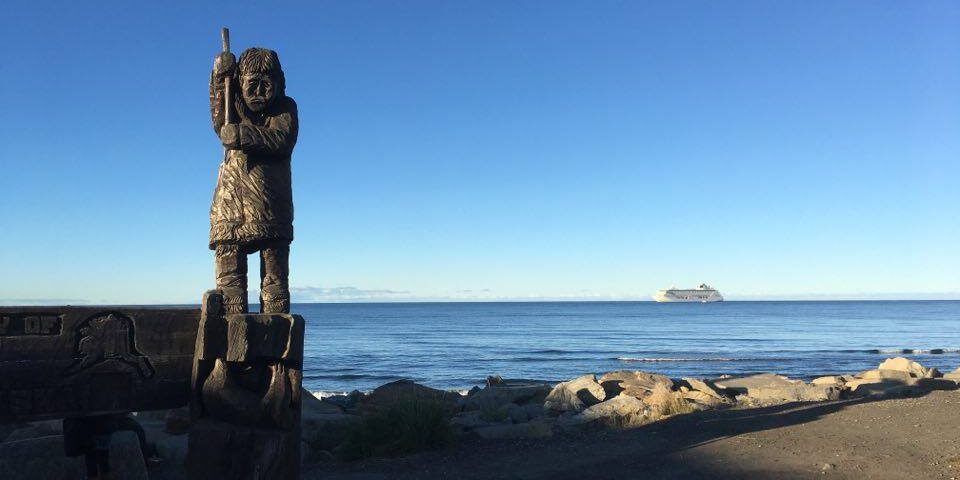The luxury cruise liner Crystal Serenity, which stopped in Nome last month, won’t be coming around to Alaska again for at least two years. The passengers it unloaded in New York City Saturday morning will be the last on its Northwest Passage route until at least 2020.
According to Crystal Cruises, the ship was booked full last year with nearly 1,000 passengers, but the numbers weren’t quite so high this summer, with around 20 percent fewer bookings. At 32 days, the Northwest Passage cruise is one of the longest operated by the company. It’s also one of the most expensive, with fares ranging from around $20,000 to over $120,000 per person.
These price tags are an indicator of the economic boost such a ship brings with it. Robert Hafner is executive director of the Nome Chamber of Commerce. And he says the impact in Nome is more far-reaching than you might think:
“The gift shops tend to go out and buy from a lot of the local people to supply their gift shops with the goods they need to sell to the tourists. We know the restaurants that provide the catering. Buses that are hired require the bus drivers there — which, because the bus is being used, they have to buy fuel. There’s a big trickle-down effect to a cruise boat that a lot of people don’t really look at.”
Hafner says the absence of the Serenity in the coming years could be significant.
“A lot of our businesses, they ramp up for it. They buy extra gear getting ready to supply those customers. That kind of money that’s not flowing through our community, even if it’s just one day, we need. And that’s too bad that at this time they are not intending to come back.”
For local businesses and artists on the ground last month, results were mixed. Angela Hansen, who coordinated vendors for the Berry Festival in Anvil City Square, says Native carvers did especially well; a number of passengers off the Serenity purchased large, expensive pieces.
And Hannah Katongan, who was working a fundraiser for her basketball team, says their food was very popular:
“Dedicated Donna, she had to go back and make more Akutaq (Eskimo ice cream). And then we had reindeer stew — that sold out as well.”
But overall, Hansen says, about two-thirds of the total revenue still came from locals.
For Pingo Bakery and Seafood House, right on the square, it was a busy day — “Iditarod busy,” as chef and owner Erica Pryzmont says. But her business approach was the same:
“Any day, whether you think it’s going to be a big day or not, your goal is basically to make as much food as you can to meet the demand without making crazy too much. The trick is: You never know what the cool food of the day is going to be.”
Pingo sources much of its food locally, especially fish. Though cruise-ship passengers contribute to the local economy, large vessels like Serenity can also pose a threat to the wildlife harvested for food and goods.
Austin Ahmasuk is a marine advocate for Kawerak, and in workshops he’s led throughout Western Alaska, he says communities have reiterated:
“We should not underestimate the potential impacts from increased shipping: discharge in all of its forms, impacts potentially from noise disrupt our marine life. And then impacts from oil spills, of course, affect food security.”
The environmental advocacy group Friends of the Earth gave Crystal Cruises an “F” on its 2016 Cruise Ship Report Card. The assessment factors in sewage treatment, air pollution reduction, and water quality compliance.
According to Ed White, an environmental specialist with the State of Alaska’s Cruise Ship Monitoring Program, Serenity was nearly in full compliance with state requirements when inspected earlier this year.
But Ahmasuk says that could be misleading, since those requirements only apply to the state waters near shore. Although there is a sewage treatment system on board the ship, he says, “Outside of 12 miles they can simply turn that thing off and discharge raw blackwater, greywater.”
John Stoll, vice president for land operations with Crystal Cruises, says the ship takes a number of environmental precautions, including low-grade fuel, freezing garbage, and:
“We actually have a reverse osmosis machine on board, so we make our own water on board. And then as far as black- and grey-water, we wait to displace that as well — we’ll keep that on the Shackleton (the British icebreaker accompanying the Serenity through the Northwest Passage) — so we don’t disperse any of that while we’re in the northern regions. So, again, there’s a real concerted effort on behalf of the ship to make sure we’re as clean as we can possibly be in that part of the world.”
Such efforts — expensive ones, as Stoll notes — may not be required for Crystal with Serenity away from the Arctic.
And with a big source of economic stimulation absent, Hafner argues that Nome should shift its focus: away from cruises and towards attracting smaller boats, by investing in more amenities like shower facilities, a laundromat, and more reliable internet services. In the end, he says:
“The people of Nome need to really search our souls and see how our economy is changing here, and what we can do to sustain ourselves as a city so that we can go forward.”
With the cruise season winding down in Alaska and finished in Nome, the city will have to see what soul-searching opportunities come through next year.
Image at top: the cruise liner Crystal Serenity anchored offshore at Nome, 2017. Photo: Gabe Colombo, KNOM.







